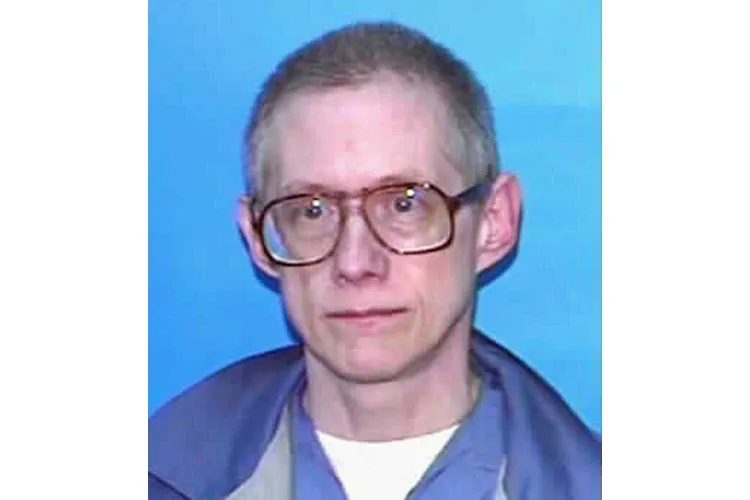How One Woman Escaped John Crutchley, Florida’s “Vampire Rapist,” After 20 Hours of Torture — And Exposed a Hidden Web of Horror
In November 1985, a 19-year-old woman named Laura Murphy was hitchhiking in Florida when she accepted a ride from a seemingly ordinary man. That decision would plunge her into more than 20 hours of unspeakable anguish at the hands of John Brennan Crutchley — a man later dubbed the “Vampire Rapist.” What Murphy endured, and ultimately survived, stands as one of the most shocking cases of sexual violence and torture ever documented in the United States. Her escape would expose not only Crutchley’s horrific acts but also the broader failures of law enforcement and the thin line between everyday consumer and monster.

It began one evening on November 21, 1985. Murphy had been hitchhiking toward Melbourne, Florida, when Crutchley picked her up. According to police records, he told her they’d stop at his home for a moment while he retrieved a notebook he needed for work. When she declined to go inside, he responded with violence. He choked her unconscious, dragged her into his Malabar house, stripped her naked, bound her arms and legs, and strapped her to his kitchen counter. He set up lights and a video camera to record the ordeal.
As Murphy regained consciousness, she realized her worst fears had come true. Crutchley raped her repeatedly. He inserted syringes to draw her blood — amounting to approximately 40–45 percent of her blood volume. He told her he was a vampire. He filmed her in bondage, put her in the bathtub, and threatened her with the arrival of his brother if she tried to escape.
By November 22 she saw a chance. Crutchley had left her alone in the bathroom. She managed to wiggle free, squeeze through the window, and crawl naked and handcuffed along a roadside until a passing motorist stopped and called police. When she arrived at the hospital, she was bleeding profusely and the doctors told her she would have died within 12 hours without intervention.
The arrest of Crutchley was swift, but the full extent of his crimes remains a haunting question. Inside his home investigators discovered bondage gear, syringes, videotapes, and personal items belonging to other women — temptingly suggesting the possibility of dozens of additional victims. FBI profiler Robert Ressler later concluded that Crutchley was “very likely” a serial killer of the “organized type.” He was linked by authorities to as many as 24–30 disappearances and murders across several states, though no other charges were ever brought.
In June 1986 Crutchley pleaded guilty to kidnapping and sexual battery. He was sentenced to 25 years to life. He later was released on parole after serving 10–11 years, but went back to prison on a drug violation. In March 2002 he was found dead in his cell, in circumstances ruled to be autoerotic asphyxiation.
Murphy’s survival story is remarkable not only for her escape from imminent death, but for the courage she displayed afterward. She testified against Crutchley and enabled further investigation into his crimes. While she largely stepped out of the public spotlight afterward, her case has become a cautionary tale in victim resilience and the dark corners of human deviance.
Crutchley himself did not fit the profile of the overtly monstrous killer that many expect. He held a job as a systems engineer for Harris Corporation, with a high security clearance and access to sensitive government contracts. He lived in a comfortable home. But beneath that façade was a secret world of torture, blood-ritual, and predation. According to one scholar, “there was nothing about him which would send danger signals to potential victims.” His case forced law enforcement and criminologists to revisit assumptions about how evil can masquerade as everyday normalcy.
The impact of Murphy’s experience extends beyond her individual trauma. It sparked debates about how cases of extreme violence are handled, how victims talk about taboo subjects like blood extraction, and how law enforcement weighs evidence when victims survive with near‐fatal injuries. It raised questions about why so many of Crutchley’s alleged victims were never found or charges filed, and how states coordinate across jurisdictions when suspects travel and kill in multiple places.
While Murphy’s ordeal ended with her escape, it left psychological scars. Victims of such violence often carry long-term trauma: PTSD, nightmares, survivor guilt, and a lifetime of reminders. Murphy has largely remained private, but her story continues to carry weight for advocates working on behalf of sexual assault survivors. In many interviews and retrospectives, she emphasizes that surviving mattered — and telling her story mattered.
Crutchley’s case also remains open in many unsolved homicide investigations. The Brevard County Sheriff’s Office in Florida closed its official investigation in 1996 without filing additional murder charges, despite the FBI’s belief there were far more victims. That unresolved aspect haunts the case: how many more women did he kill? How many families still wait for answers?
Today, as the story resurfaces in media retrospectives, the memory of November 1985 remains chilling. It stands as a stark reminder that sometimes the most terrifying monsters hide in plain sight — professionally dressed, courteous, unassuming. And yet their victims survive and testify, flipping the narrative from helplessness to testimony, from victimhood to voice.
Laura Murphy’s escape was not just an act of survival. It was an act that prevented further harm. It uncovered one of the darkest criminal cases Florida has ever seen. Her courage in the aftermath has allowed justice to be pursued — imperfectly, but persistently. For that reason, the label “escaped vampire rapist” should never overshadow the person who lived to expose the hidden horrors.
In the end, the story of Laura Murphy and John Crutchley is not just a tale of terror. It is a tale of survival, of courage in unimaginable darkness, and of the power of one person’s escape to shine a light into the hidden corners of human evil.


